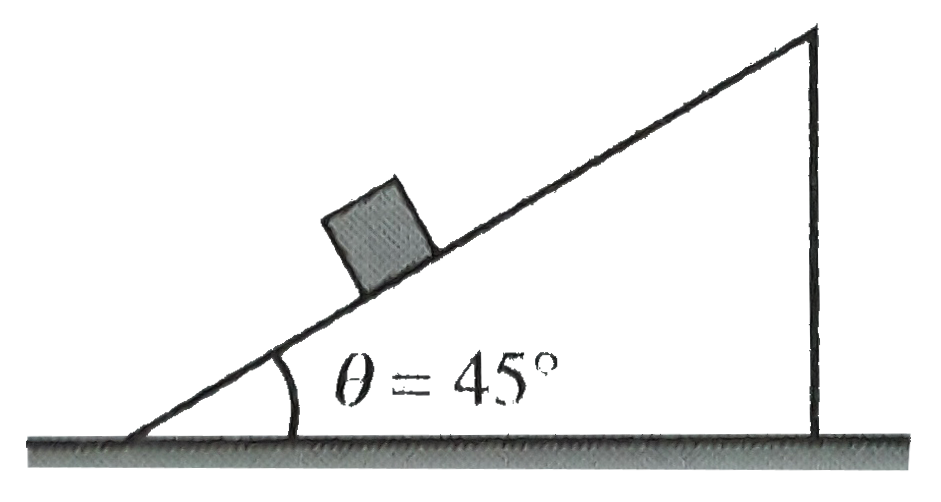A block is kept on a smooth inclined plane of angle of inclination that moves wuth a contact acceleration so that the block does not slide relative to the inclined plane. If the inclined plane stops the normal contact force offered by the plane on the block changes by a factor
The correct Answer is:C
To solve the problem, we will analyze the forces acting on the block on the inclined plane and how they change when the inclined plane stops.
1. Identify the Forces Acting on the Block:
- The block experiences gravitational force mg acting downwards.
- The normal force N acts perpendicular to the surface of the inclined plane.
2. Consider the Motion of the Inclined Plane:
- The inclined plane is moving with a constant acceleration a.
- Since the block does not slide relative to the inclined plane, it is in a non-inertial frame of reference.
3. Analyze the Forces in the Non-Inertial Frame:
- When the inclined plane accelerates, the effective gravitational force acting on the block can be modified due to the acceleration of the inclined plane.
- The effective force acting on the block in the direction perpendicular to the inclined plane can be expressed as:
Ncos(θ)=mg−masin(θ)
- Here, masin(θ) is the pseudo force acting on the block due to the acceleration of the inclined plane.
4. Determine the Normal Force N1:
- Rearranging the equation gives:
N=mg−masin(θ)cos(θ)
5. Consider the Case When the Inclined Plane Stops:
- When the inclined plane stops, the acceleration a becomes zero.
- Thus, the normal force N1 when the inclined plane is moving with acceleration becomes:
N1=mgcos(θ)
6. Normal Force Without Acceleration N2:
- When the inclined plane is not accelerating (stopped), the normal force N2 acting on the block is given by:
N2=mgcos(θ)
7. Finding the Ratio of Normal Forces:
- Now, we can find the change in the normal force when the inclined plane stops:
N2N1=mgcos(θ)mgcos(θ)=cos2(θ)
8. Conclusion:
- Therefore, the normal contact force offered by the plane on the block changes by a factor of cos2(θ).
Final Answer:
The normal contact force changes by a factor of cos2(θ) (Option 3).
- The block experiences gravitational force mg acting downwards.
- The normal force N acts perpendicular to the surface of the inclined plane.
- The inclined plane is moving with a constant acceleration a.
- Since the block does not slide relative to the inclined plane, it is in a non-inertial frame of reference.
- When the inclined plane accelerates, the effective gravitational force acting on the block can be modified due to the acceleration of the inclined plane.
- The effective force acting on the block in the direction perpendicular to the inclined plane can be expressed as:
Ncos(θ)=mg−masin(θ)
- Here, masin(θ) is the pseudo force acting on the block due to the acceleration of the inclined plane.
- Rearranging the equation gives:
N=mg−masin(θ)cos(θ)
- When the inclined plane stops, the acceleration a becomes zero.
- Thus, the normal force N1 when the inclined plane is moving with acceleration becomes:
N1=mgcos(θ)
- When the inclined plane is not accelerating (stopped), the normal force N2 acting on the block is given by:
N2=mgcos(θ)
- Now, we can find the change in the normal force when the inclined plane stops:
N2N1=mgcos(θ)mgcos(θ)=cos2(θ)
- Therefore, the normal contact force offered by the plane on the block changes by a factor of cos2(θ).
The normal contact force changes by a factor of cos2(θ) (Option 3).
Topper's Solved these Questions
- LAWS OF MOTIONBook:DC PANDEY ENGLISHChapter:LAWS OF MOTIONExercise:Objective Question
Explore 32 Videos
- LAWS OF MOTIONBook:DC PANDEY ENGLISHChapter:LAWS OF MOTIONExercise:Comprehension
Explore 9 Videos
- LAWS OF MOTIONBook:DC PANDEY ENGLISHChapter:LAWS OF MOTIONExercise:Assertion And Reason
Explore 28 Videos
- KINEMATICS 1Book:DC PANDEY ENGLISHChapter:KINEMATICS 1Exercise:INTEGER_TYPE
Explore 15 Videos
- LAWS OF THERMODYNAMICSBook:DC PANDEY ENGLISHChapter:LAWS OF THERMODYNAMICSExercise:Level 2 Subjective
Explore 18 Videos
Similar Questions
A block is kept on a smooth inclined plane of angle of inclination 30∘ that moves with a constant acceleration so that the block does not slide relative to the inclined plane. Let F1 be the the contact force between the block and the plane . Now the inclined plane stops and let F2 be the contact force between the two in this case. Then, F1/F2 is
View SolutionA block of mass m is placed on a smooth inclined plane of inclination θ with the horizontal. The force exerted by the plane on the block has a magnitude
View SolutionA block of mass m is placed on a smooth inclined plane of inclination θ with the horizontal. The force exerted by the plane on the block has a magnitude
View SolutionA block of mass m=3kg slides on a rough inclined plane of cofficient of friction 0.2 Find the resultant force offered by the plane on the block

View SolutionA block of mass m is kept on an inclined plane is angle inclination θ(<ϕ), where ϕ= angle of friction. Then :

View SolutionA block can slide on a smooth inclined plane of inclination θ kept on the floor of a lift. When the lift is descending with a retardation a , the acceleration of the block relative to the incline is
View SolutionA block can slide on a smooth inclined plane of inclination θ kept on the floor of a lift. When the lift is descending with a retardation a , the acceleration of the block relative to the incline is
View SolutionA block can slide on a smooth inclined plane of inclination θ kept on the floor of a lift. When the lift is descending with a retardation a , the acceleration of the block relative to the incline is
View SolutionA block slides down on inclined plane (angle of inclination 60∘ ) with an accelration g/2 Find the coefficient friction

View SolutionA block of mass 10 kg is kept on a fixed rough (μ=0.8) inclined plane of angle of inclination 30∘. The frictional force acting on the block is

View Solution
